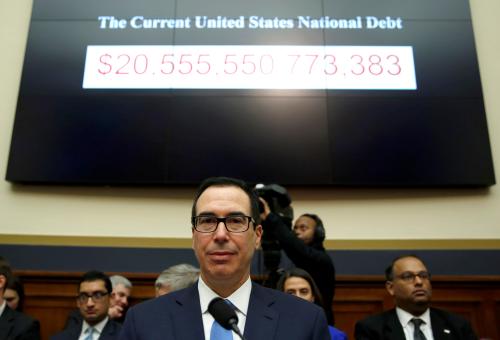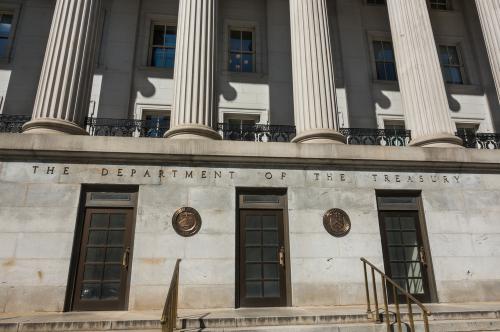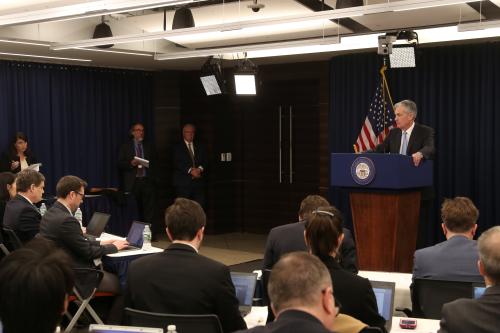This article originally appeared in Real Clear Markets on April 12, 2018.
When Congress enacted tax legislation in December 2017, commentators debated whether the tax bill was fair or good for economic growth. When Congress struck a budget deal in February 2018, members of Congress congratulated themselves on avoiding a government shutdown. Some commentators warned that added stimulus from reduced taxes and added spending could cause an economy already near full employment to overheat.
But what went unremarked was that these two actions effectively spiked any weapons to fight the next recession. Were another financial crisis to emerge, an economic shock from somewhere in this terrifyingly unstable world, there is very little Congress, the Federal Reserve, or anyone else would be able to do to shield the U.S. workers and businesses from it.
To be sure, the economy is currently strong. But economic expansions don’t last forever. The current one is nearly nine years old and is the second longest on record. Sooner or later, another recession will come. Customarily, two tools are used to combat recessions—monetary policy or fiscal policy—if they are available. Right now, neither is. And that means that the next recession will be longer and deeper than it has to be.
Monetary policy is now largely sidelined. In 2008 and 2009 the Federal Reserve (FED) aggressively drove the interest rate it controls to zero and kept it there. That action and others helped prevent a major recession from metastasizing into a catastrophic depression. Continued low interest rates have helped sustain economic recovery.
Were another financial crisis to emerge, an economic shock from somewhere in this terrifyingly unstable world, there is very little Congress, the Federal Reserve, or anyone else would be able to do to shield the U.S. workers and businesses from it.
The FED’s managers are currently trying gradually to boost interest rates, partly to prevent the current economic expansion from getting out of hand and partly to restore its own capacity to lower rates when the next recession comes along. Eventually, the FED will be better positioned to confront a recession than it is today. For now, the FED’s strongest weapon is largely sidelined if recession strikes.
The situation with respect to fiscal policy is even more disturbing. Congress’s action to cut taxes and raise spending at a time when the economy is already near full employment could cause the economy to overheat and weakens the ability to use fiscal policy to fight the next recession.
To appreciate why, it helps to look back to 2007, just before the financial meltdown triggered the Great Recession. Federal government debt held by the public equaled a modest 35 percent of GDP, a low ratio compared to past levels in the United States and well below that of other developed nations. Policy makers had little objective reason to worry that increasing spending or cutting taxes to fight the recession would push debt to unsustainable levels. Even so, Congress was so uneasy about boosting spending or cutting taxes to fight the effects of financial meltdown that the Obama administration asked for a smaller anti-recession program in 2009 than internal advisors thought desirable. And as soon as the economy began to recover, a sort of deficit mania took hold. Fiscal stimulus ended, and the recovery slowed to a tortured crawl.
It is not difficult to imagine the situation when the next recession hits. The ratio of debt to GDP is now twice what it was at the start of the last recession. The debt/GDP ratio is headed up, rather than down, as is normally the case when the economy is near full employment. The budget deficit is projected to surpass $1 trillion in 2020, even as unemployment is projected to sink to levels unseen in the last 50 years. Were a recession to occur, deficits would approach or even exceed $2 trillion a year as tax collections fall and spending triggered by rising unemployment rises. This flood of red ink would cause elected officials to worry—and even panic—about rising debt. Whether or not such fears would be well-founded, they would be genuine and widespread. Frightened legislators would be loath to enact even well-considered short term recession-fighting measures out of fears that doing so would push up deficits and debt even more.
The simple fact is that right now, the United States is largely bereft of weapons to fight a recession. Recent research by David and Christina Romer quantifies those risks. Economic activity in countries, free to use monetary and fiscal policy aggressively to fight recessions, typically returns to pre-recession levels within three years. In countries without capacity to use either monetary or fiscal policy aggressively, GDP remains about 10 percent below pre-recession levels after 3½ years. In the U.S. context, the cumulative loss of GDP over five years following the onset of a moderately severe recession would be in the range of $6-7 trillion, about one-third of one year’s GDP.
What this means is that the December 2017 legislation to cut taxes and the February 2018 legislation to boost spending rashly weakened the already tenuous capacity of policy makers to deal with the next recession. Even if one is not outraged that the tax cuts flow mostly to the well-to-do, who have enjoyed the lion’s share of growth in pre-tax incomes, the tax cuts should be rescinded. They give short-term pleasure to the wealthy few at the expense of serious losses for all Americans, rich and poor alike.
The Brookings Institution is committed to quality, independence, and impact.
We are supported by a diverse array of funders. In line with our values and policies, each Brookings publication represents the sole views of its author(s).





Commentary
Op-edTax and spending legislation disarms us against next recession
April 12, 2018